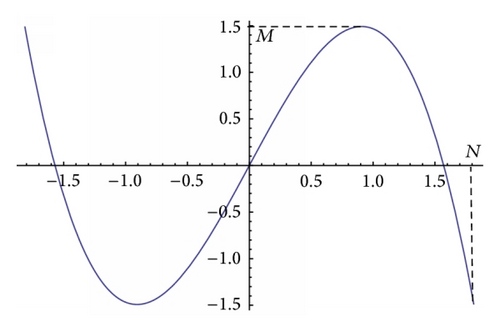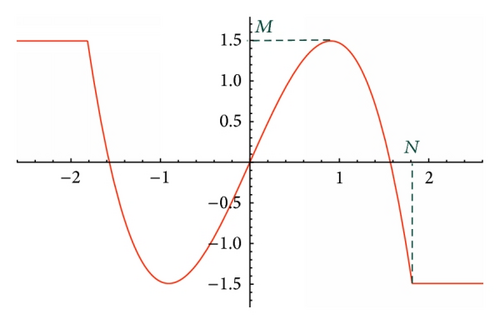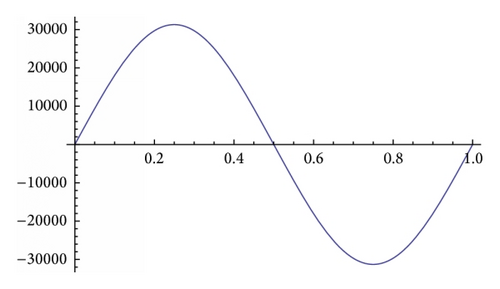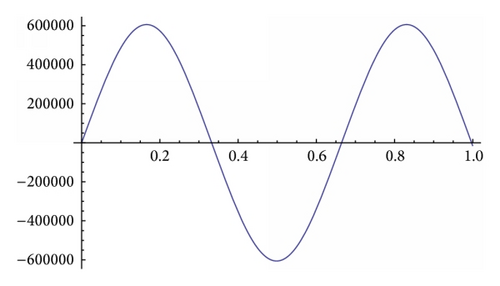Resonant Problems by Quasilinearization
Abstract
The Dirichlet resonant boundary value problems are considered. If the respective nonlinear equation can be reduced to a quasilinear one with a nonresonant linear part and both equations are equivalent in some domain Ω and if solutions of the quasilinear problem are in Ω, then the original problem has a solution. We say then that the original problem allows for quasilinearization. If quasilinearization is possible for essentially different linear parts, then the original problem has multiple solutions. We give conditions for Emden-Fowler type resonant boundary value problem solvability and consider examples.
1. Introduction
If this is not true the existence of a solution cannot be proved. There are examples, for instance, x′′ + π2x = 1, x(0) = 0 and x(1) = 0 showing that a solution does not exist. This type of problems are called resonant problems.
There is an intensive literature on resonant problems. We mention several papers [5–13].
To treat resonant problems, various approaches were used. We focused on the quasilinearization method [14, 15], which consists in reducing the resonant problem to nonresonant one using suitable estimations of expected solutions.
Below we give a description of the quasilinearization method.
Definition 1. The linear part (l2x)(t): = x′′ + p(t)x′ + q(t)x of differential equation (6) is called a nonresonant with respect to the boundary conditions (7) if the homogeneous problem
The classical result states that the problem (6) and (7) is solvable if linear part (l2x)(t) is nonresonant and f is continuous and bounded (the Picard theorem [3]). Therefore it is desirable to obtain the conditions for the boundary value problem (6) and (7) to be solvable for resonant linear parts.
The function f in the Landesman-Lazer condition is of the specific form h(t) − g(u(t)). And it is an actual question to find the conditions ensuring that the problem (6) and (7) is solvable if f = f(t, x, x′).
Our main result in this paper is to get conditions which guarantee that the resonant boundary value problem is solvable and we do not use the Landesman-Lazer condition.
If such reduction is possible then according to Conti′s theorem [17] the modified problem (14) and (7) is solvable.
If a solution x(t) of the modified quasilinear problem (14) and (7) is located in the domain Ω(t, x, x′), where both (6) and (14) are equivalent, then the original problem (6) and (7) at resonance has a solution.
Our paper consists of the introduction, four sections, conclusions and references.
Definitions of the type of a solution to Dirichlet boundary value problems are given in Section 2. The general result and related auxiliary results for quasilinear problems are stated.
In Section 3 we describe quasilinearization process and formulate and prove the theorem for resonant boundary value problem (6) and (7) to be solvable.
In Section 4 the idea of quasilinearization is applied to the investigation of the Emden-Fowler type resonant boundary problem.
In Section 5 we consider an example.
2. Auxiliary Results
We consider quasilinear problem (14) and (7).
Theorem 2 (see [17].)If F(t, x, x′) in (14) is a continuous and bounded function and the homogeneous problem (15) has only the trivial solution, then the problem (14) and (7) is solvable.
Definition 3 (see [14], [15].)We will say that the linear part (L2x)(t) is i-nonresonant with respect to the boundary conditions (7), if a solution x(t) of the Cauchy problem
Definition 4 (see [14], [15].)We will say that ξ(t) is an i-type solution of the problem (6) and (7) (resp., (14) and (7)) if for small enough r > 0 the difference u(t; r) = x(t; r) − ξ(t) has exactly i zeros in (a, b) and u(b; r) ≠ 0, where x(t; r) is a solution of (6) (resp., (14)), which satisfies the initial conditions
Theorem 5 (see [15], Theorem 2.1.)Quasilinear problem (14) and (7) with an i-nonresonant linear part (L2x)(t) has an i-type solution.
The proof can be found in [14, 15].
Definition 6. Let (6) and (14), where the linear part (L2x)(t) is nonresonant with respect to the boundary conditions (7) in the interval I, be equivalent in the domain
The following results in [14, 15] form a basis for application of the quasilinearization process for proving the existence of multiple solutions.
Theorem 7 (see [14], [15].)If the problem (6) and (7) allows for quasilinearization with respect to some domain Ω1 and some i-nonresonant linear part (L2x)(t), then it has an i-type solution.
Theorem 8 (see [14], [15].)Suppose that the problem (6) and (7) allows for quasilinearization with respect to Ω1 and i-nonresonant linear part (L2x)(t), and, at the same time, it allows for quasilinearization with respect to a domain
3. Preliminary Results
We consider the resonant problem (6) and (7), where f(t, x, x′) is continuous function and the linear part (l2x)(t) is resonant.
- (1)
First we modify the equation adding a linear part so that the resulting linear part is not resonant yet
(26) - (2)
We choose constants N > 0 and N1 > 0 and truncate right side:
(27)where(28) - (3)
We check the inequalities
(29)where Γ and Γ1 are the estimates of Green′s function and its derivative associated with the linear part in (27); .
Theorem 10. Suppose that ɛ2, N and N1 as above can be found such that the inequalities
Then the problem (6) and (7) has a solution such that |x(t)| ≤ N ∀t ∈ [a, b] and |x′(t)| ≤ N1∀t ∈ [a, b].
Proof. Apply (26) and (27). From Theorem 2 the boundary value problem (27) and (7) is solvable and has a solution x(t), which can be written in the integral form using Green′s function.
The inequalities (30) and (31) are fulfilled. This means that
It follows that x(t) is also a solution of the original problem (6) and (7).
4. Application: Emden-Fowler Type Equation
Theorem 12. Suppose that
Proof. Let us consider instead of (34) the equivalent one
Figure 1 illustrates the case of p > 1 for fixed t = t*.
We can calculate the value of the function at the point of maximum x0. Set
Let us consider the quasilinear equation
The modified quasilinear equation (48) is equivalent to the given equation (34) in the respective domains
The problem (48) and (35) is solvable and solutions can be written in integral form
Then k should satisfy the inequalities
Consider inequality (55) and assume that q(t) satisfies the estimates (36). If p > 1, then

We have computed results (see Table 1) for q = 1, various p, which show that some k2 satisfy inequality (37). It may happen that several k fall into the same nonresonance interval . In Table 1 we select only one k for any respective nonresonance interval (this prevents an error when estimating the number of solutions of different types). For instance, in the case p = 3/2, two values of k, namely, k = 1 and k = 3, fall into the same nonresonance interval . We show only k = 1 in Table 1. Intervals of nonresonance are given in the third column of Table 1.
| p | i | Nonresonant intervals | k | ΓMk | Nk |
|---|---|---|---|---|---|
| 3 | 1 | 1 | 1.172 | 1.814 | |
| 2 | 1 | 1 | 1.196 | 2.978 | |
| 3/2 | 1 | 1 | 1.748 | 7.616 | |
| 4/3 | 1 | 1 | 3.071 | 19.083 | |
| 2 | 5 | 219478 | 298164 | ||
| 3 | 7 | 2.178 · 106 | 2.245 · 106 | ||
| 5/4 | 1 | 1 | 5.886 | 47.492 | |
| 2 | 5 | 1.052 · 107 | 1.855 · 107 | ||
| 3 | 7 | 2.045 · 108 | 2.738 · 108 | ||
| 4 | 9 | 1.917 · 109 | 2.044 · 109 | ||
| 6/5 | 1 | 1 | 11.875 | 117.828 | |
| 2 | 5 | 5.304 · 108 | 11.507 · 108 | ||
| 3 | 7 | 2.021 · 1010 | 3.328 · 1010 | ||
| 4 | 9 | 3.132 · 1011 | 4.108 · 1011 | ||
| 5 | 11 | 2.813 · 1012 | 3.056 · 1012 | ||
| 5/6 | 1 | 1 | 0.00148 | 0.00601 | |
| 2 | 5 | 1.078 · 10−11 | 2.460 · 10−11 | ||
| 3 | 7 | 2.506 · 10−13 | 4.339 · 10−13 | ||
| 4 | 9 | 1.541 · 10−14 | 2.127 · 10−14 | ||
| 5 | 11 | 1.675 · 10−15 | 1.914 · 10−15 | ||
| 4/5 | 1 | 1 | 0.0017 | 0.0149 | |
| 2 | 5 | 8.132 · 10−10 | 15.264 · 10−10 | ||
| 3 | 7 | 3.706 · 10−11 | 5.277 · 10−11 | ||
| 4 | 9 | 3.767 · 10−12 | 4.275 · 10−12 | ||
| 3/4 | 1 | 1 | 0.0055 | 0.0371 | |
| 2 | 5 | 6.459 · 10−8 | 9.502 · 10−8 | ||
| 3 | 7 | 5.768 · 10−9 | 6.439 · 10−9 | ||
| 2/3 | 1 | 1 | 0.0191 | 0.0931 | |
| 1/6 | 1 | 1 | 0.382 | 0.566 | |
Example 13. For instance, we consider the resonant equation
Function −|x|3signx is odd. And for x > 0 we can rewrite
Rewrite (62) equivalently:
We would like to make the function f(x): = (π2/4)x − x3 bounded and still continuous. The function f(x) is an odd function with a maximum at (cf. Figure 2). Define . Solve the equation f(x) = −M for x > 0. The solution is .
Define the truncated function
The function F(x) is continuous and bounded by the number M (cf. Figure 3). Therefore the problem
A solution x(t) of (66) satisfies the integral equation
Then,
The problem




5. Example: Equation x′′ + π2x = −x7 + x5 − x3
This means that for this example the problem (73) allows for quasilinearization with respect to the linear part (L2x)(t): = x′′ + (π2/4)(4 + k2)x, where k = 1. Using quasilinearization process we can say that resonant boundary problem (73) is solvable.
6. Conclusions
We show that the resonant boundary value problem can be studied by using a quasilinearization process. The respective cases are considered, when the differential equations of resonant type with bounded or unbounded right side function allow for quasilinearization. As an application the conditions for solvability of the Emden-Fowler type resonant boundary value problem are given. Two examples are considered in detail showing the quasilinearization approach in action. By using quasilinearization process with different linear parts we can state the existence of different solutions of a problem thus obtaining multiplicity of results.
Conflict of Interests
The author declares that there is no conflict of interests regarding the publication of this paper.




